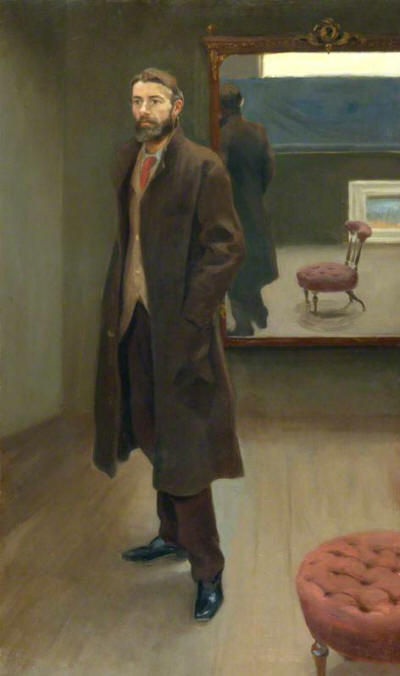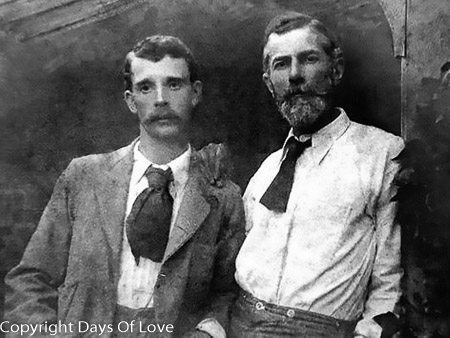

Partner George Merrill, buried together
Queer Places:
University of Cambridge, 4 Mill Ln, Cambridge CB2 1RZ
Brighton College, Eastern Rd, Brighton BN2 0AL, UK
45 Brunswick Square, Hove BN3, UK
Cordwell Ln, Dronfield S18 7WF, UK
Millthorpe, Mountside, Guildford GU2 4JD, UK
17 Wodeland Ave, Guildford GU2 4JX, UK
Joseph's Rd, Guildford GU1 1DN, UK
Mountside Cemetery, Guildford GU2 4JB, UK
 Edward
Carpenter (29 August 1844 – 28 June 1929) was an English
socialist
poet,
philosopher,
anthologist, and early activist for
rights for homosexuals.[1]
Other than
George Merrill,
he had also a relationship with
Charles Robert Ashbee, the romantic socialist.
The Peak of Terror (1873) and Homogenic Love (1894) are cited as examples in Sexual Heretics: Male Homosexuality in
English Literature from 1850-1900, by Brian Reade.
Edward
Carpenter (29 August 1844 – 28 June 1929) was an English
socialist
poet,
philosopher,
anthologist, and early activist for
rights for homosexuals.[1]
Other than
George Merrill,
he had also a relationship with
Charles Robert Ashbee, the romantic socialist.
The Peak of Terror (1873) and Homogenic Love (1894) are cited as examples in Sexual Heretics: Male Homosexuality in
English Literature from 1850-1900, by Brian Reade.
A poet and writer, he was a close friend of Rabindranath Tagore, and a friend of Walt Whitman.[2] He corresponded with many famous figures such as Annie Besant, Isadora Duncan, Havelock Ellis, Roger Fry, Mahatma Gandhi, Keir Hardie, J. K. Kinney, Jack London, George Merrill, E. D. Morel, William Morris, Edward R. Pease, John Ruskin, and Olive Schreiner.[3]
As a philosopher he was particularly known for his publication of Civilisation, Its Cause and Cure in which he proposes that civilisation is a form of disease that human societies pass through.[4]
An early advocate of sexual freedoms, he had an influence on both D. H. Lawrence and Sri Aurobindo, and inspired E. M. Forster's novel Maurice.[5]
The British Society for the Study of Sex Psychology (BSSSP), of which Edith Lees Ellis was a member, was established in 1913 to provide a forum for the discussion of new ideas in the field of sex reform. The first woman member of the society was the militant suffragist Cicely Hamilton, and she was soon joined by a number of other notable feminists, such as Kathlyn Oliver and Stella Browne, and by Mrs Mary Scharlieb, one of the first women to gain a medical qualification in Britain. The membership of these women suggests that feminism and sexuology were not necessarily antithetical views and feminists did not reject the idea of sexologists such as Havelock Ellis and Edward Carpenter.

by Roger Fry

On Carpenter's return from India in 1891, he met George Merrill, a working class man also from Sheffield, 22 years his junior, and the two men struck up a relationship, eventually cohabiting in 1898.[7] Merrill had been raised in the slums of Sheffield and had no formal education. Their relationship endured and they remained partners for the rest of their lives, a fact made all the more extraordinary by the hysteria about homosexuality generated by the Oscar Wilde trial of 1895. Carpenter remarked in his work The Intermediate Sex:
Eros is a great leveller. Perhaps the true Democracy rests, more firmly than anywhere else, on a sentiment which easily passes the bounds of class and caste, and unites in the closest affection the most estranged ranks of society. It is noticeable how often Uranians of good position and breeding are drawn to rougher types, as of manual workers, and frequently very permanent alliances grow up in this way, which although not publicly acknowledged have a decided influence on social institutions, customs and political tendencies.[16]
George Merrill to Edward Carpenter, 8 November 1896: Dear Ted [. . .] I shall be glad to see thy dear face again as I have such longings to kiss those sweet lips of thine. I will wait till I hear from you, first. So I must close dear heart as I am feeling a little low and lonesome. I’m always with thee every night in spirit, fondest love from your dear Boy G XXX.
Carpenter included among his friends the scholar, author, naturalist, and founder of the Humanitarian League, Henry S. Salt, and his wife, Catherine;[17] the critic, essayist and sexologist, Havelock Ellis, and his wife, Edith; actor and producer Ben Iden Payne; Labour activists, John Bruce and Katharine Glasier; writer and scholar, John Addington Symonds; and the writer and feminist, Olive Schreiner.[18] E. M. Forster was also close friends with the couple, who on a visit to Millthorpe in 1912 was inspired to write his gay-themed novel, Maurice.[19] Forster records in his diary that Merrill "...touched my backside - gently and just above the buttocks. I believe he touched most people's. The sensation was unusual and I still remember it, as I remember the position of a long vanished tooth. He made a profound impression on me and touched a creative spring."[7]
The relationship between Carpenter and Merrill was the template for the relationship between Maurice Hall and Alec Scudder, the gamekeeper in Forster's novel.[19] Carpenter was also a significant influence on the author D. H. Lawrence, whose Lady Chatterley's Lover can be seen as a heterosexualised Maurice.[20]
In 1902 his anthology of verse and prose, Ioläus: An Anthology of Friendship, was published.[21][22][23] The book was published again in 1906 by William Swan Sonnenschein.[24]
In 1914 Carpenter founded the British Society for the Study of Sex Psychology (BSSSP) with Laurence Housman, which aimed to discuss matters around women’s sexuality and homosexuality openly and honestly and which, as one of a number of aims, campaigned to have homosexuality decriminalised.
In 1915, he published The Healing of Nations and the Hidden Sources of Their Strife, where he argued that the source of war and discontent in western society was class-monopoly and social inequality.
Carpenter was an advocate of the Christ myth theory.[25] He authored the book Pagan and Christian Creeds, 1920.
After the First World War, he had moved to Guildford, Surrey, with George Merrill[26] and the two lived at 23 Mountside Road.[27] In January 1928, Merrill died suddenly.[7] Carpenter was devastated and he sold their house and lodged for a short time, with his companion and carer Ted Inigan, at 17 Woodland Avenue, just a short walk from Mountside. They then moved to a bungalow called ‘Inglenook’ in Josephs Road.[27]
In May 1928, Carpenter suffered a paralytic stroke. He lived another 13 months before he died on 28 June 1929, aged 84.[7] He was interred, in the same grave as Merrill, at the Mount Cemetery at Guildford in Surrey.
My published books: